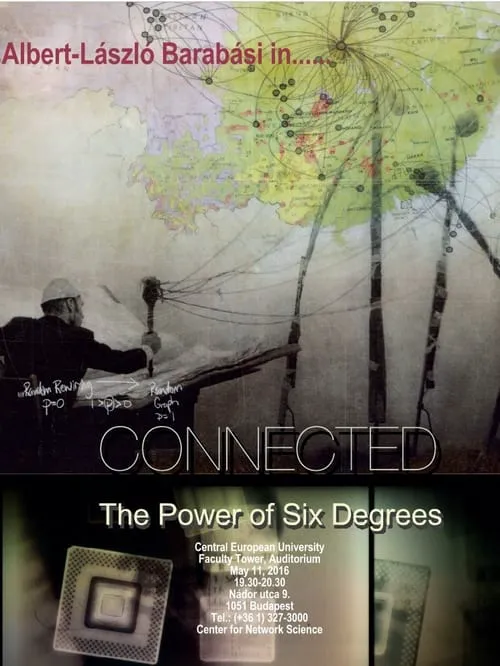The Invisible Threads: Unraveling “Connected: The Power of Six Degrees”
Released in 2015, Connected: The Power of Six Degrees captivated audiences by turning an abstract concept into a tangible, gripping cinematic journey. Directed by Cameron Carpenter, this documentary wasn’t just a film; it was an ambitious experiment, meticulously designed to pull back the curtain on the hidden architecture of human relationships and the surprising logic of network science. Exploring the age-old “six degrees of separation” idea, the film embarked on a quest to prove, firsthand, that everyone on the planet is just a handful of connections away.
From Milgram’s Hypothesis to Modern Reality
The genesis of Connected stemmed from a fascination with Stanley Milgram’s pioneering 1960s experiment, which suggested that two random people in the United States were separated by an average of just 5.5 degrees. But how would that theory hold up in the 21st century, with the advent of omnipresent digital networks? This was the driving question behind Cameron Carpenter’s vision. The immense challenge for the filmmakers lay in translating a theoretical social science concept into a visually engaging and narratively compelling story. It required more than just presenting data; it demanded a live demonstration on a global scale.
The Cinematic Experiment: Tracking the Invisible Web
The centerpiece of Connected—and arguably its most audacious production challenge—involved an unprecedented, real-time tracking experiment. The crew selected an American woman, Chelsea, at random and set out to connect her to an elderly woman in Iceland, a seemingly disparate individual chosen strategically for her remote geographic and social context.
Behind the seemingly effortless progression on screen lay weeks and months of meticulous planning and on-the-ground work. The production team had to:
- Identify Connections: This involved extensive online research, leveraging social media platforms, public records, and direct interviews to identify mutual acquaintances.
- Gain Trust and Cooperation: Each “hand-off” in the chain, from Chelsea to her immediate friends, and then to their friends, required cooperation from individuals who were suddenly part of a global documentary. The filmmakers had to explain the intricate concept to each new link, gain their consent, and establish rapport quickly, often across different cultures and time zones.
- Document Every Step: The precision with which each connection was documented—interviews, conversations, phone calls, digital footprint searches—was crucial to validating the film’s core premise. It was akin to building a human bridge, step by painstaking step, hoping it would hold. The journey itself became part of the narrative, highlighting both the surprising ease and occasional hurdles in establishing these chains.

This direct, person-to-person methodology was the cinematic backbone, illustrating the abstract “degrees” with tangible human links, making the grand concept relatable and incredibly personal.
Decoding the Digital Landscape
Beyond the initial experiment, Connected dives deep into the implications of modern technology on our social fabric. For Carpenter and his team, filming involved navigating the vast, often unseen, networks within online platforms like Facebook and Twitter. They explored diverse communities – from niche online gaming groups to sprawling professional networks – showcasing how digital spaces accelerate connection and information dissemination.
The filmmakers faced the unique challenge of visually representing abstract concepts like “homophily” (the tendency to connect with similar people) and “centrality” (the influence of “hub” individuals like celebrities). They achieved this through innovative graphics, engaging interviews with network scientists, and by featuring real-world examples that made complex theories accessible. The struggle was to illustrate how digital ecosystems, while reducing geographic distance, could simultaneously reinforce existing social echo chambers, rather than always creating bridges to diverse backgrounds.
The Director’s Vision: A Human Tapestry
Cameron Carpenter’s directorial vision for Connected extended beyond merely proving a scientific theory. He aimed to inspire a deeper understanding of humanity’s shared existence. The film seeks to illuminate the profound impact technology has on our relationships, showing how social media can reduce the world, yet also highlight its limitations in fostering truly diverse connections.
By juxtaposing scientific explanations with compelling human stories, Carpenter wanted to provoke thought about the intricate, often invisible, mechanics of our social world. The film isn’t just about how many steps it takes to connect, but what those connections mean for community, information flow, and the future of human interaction.
The Enduring Impact of Connection
Ultimately, Connected: The Power of Six Degrees stands as a testament to diligent filmmaking and profound curiosity. By merging rigorous social science with an adventurous documentary approach, the film leaves viewers with a renewed sense of wonder at the incredible, often unexpected, ways in which we are all connected. It’s a compelling look at the power of networks, not just as a scientific concept, but as a fundamental aspect of the human condition.